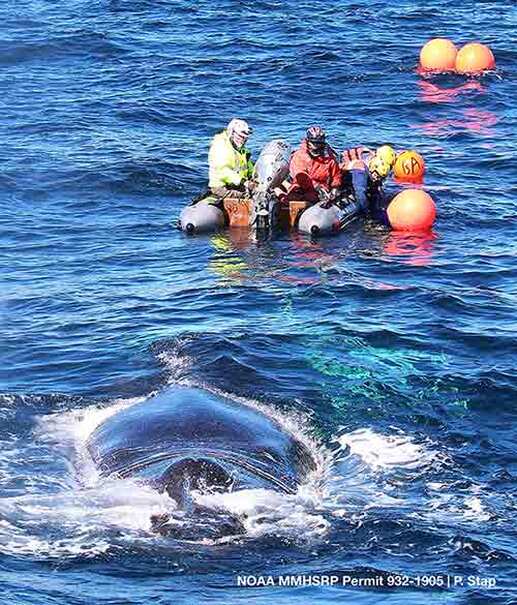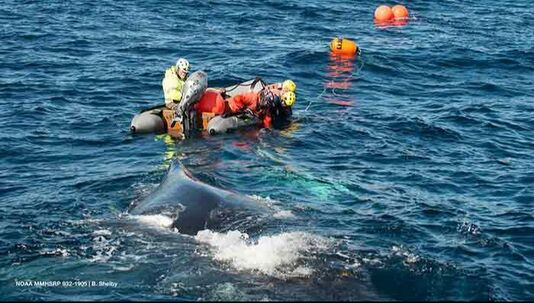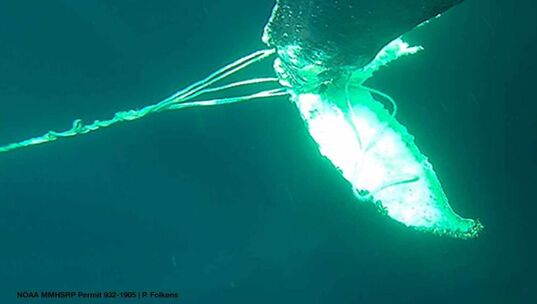|
Monterey, CA – November 1, 2014. The Whale Entanglement Team (WET)℠ disentangled another whale in the Monterey Bay National Marine Sanctuary on October 29, 2014. It is believed the whale had been entangled for three weeks. On October 4, 2014, a Waverider buoy placed approximately 25 nm west of Pt. Pinos/Monterey stopped transmitting. On Friday, October 24th, Shana Rae out of Santa Cruz was hired to check on the buoy. Arriving at the coordinates for the buoy’s mooring, Shana Rae found a whale entangled in line believed to be the mooring for the Waverider buoy. Shana Rae’s captain contacted the whale watching fleet over the radio to report the incident. The captain described the condition of the whale as “weak” and “struggling.” Fast Raft captain contacted Pieter Folkens, lead of WET, with the information.
|
Folkens spoke with the Shana Rae's captain who later sent three photos taken that afternoon, confirming the entanglement of a sub-adult humpback with significant damage to the flukes. A response was not mounted that day due to the late hour of the report and the distance offshore. Weather precluded any response over the weekend. On Wednesday, October 29th WET responded. Assets and personnel deployed included a HH-65 (Dolphin) helicopter out of USCG Air Station Alameda, the Monterey Bay National Marine Sanctuary’s 67-foot research vessel Fulmar and crew, NOAA Enforcement, a Waverider buoy representative, and eight members of the WET response team headed by Folkens. WET members are trained and respond under the auspices of NOAA's Marine Mammal Health and Stranding Response Program.
WET analyzed the entanglement video captured on an underwater camera. The video revealed a severe tail entanglement at the fluke insertion with substantial necrotic tissue. Whale lice were present and the skin on the body indicated poor health overall. They devised a plan of action and executed it which involved two cuts on the line wrapped around whale. After the cuts were made the entanglement slipped off and the whale swam away. The team was estactic to see another whale freed from a life-threatening entanglement.
Peggy Stap, Director of Marine Life Studies and founding member of WET, explained, "The feeling of joy I felt the moment when the final cut of the line was made and the young whale swam free was something I could not put into words. It was amazing to know our efforts as a team gave this whale a renewed chance to be a productive member of the local population of endangered humpback whales.”
WET is a group of 30 plus unpaid professionals (volunteers) assembled and trained for the purpose of disentangling whales. Most of WET’s core members have direct affiliations with other conservation organizations.
Meet members of WET in person Saturday, November 15, 2014 in Monterey, California at special event, Saving Whales – One at a Time, with reception following presentation. Learn first hand about the level of skill and inter-agency collaboration needed to save whales from life-threatening entanglements.
WET analyzed the entanglement video captured on an underwater camera. The video revealed a severe tail entanglement at the fluke insertion with substantial necrotic tissue. Whale lice were present and the skin on the body indicated poor health overall. They devised a plan of action and executed it which involved two cuts on the line wrapped around whale. After the cuts were made the entanglement slipped off and the whale swam away. The team was estactic to see another whale freed from a life-threatening entanglement.
Peggy Stap, Director of Marine Life Studies and founding member of WET, explained, "The feeling of joy I felt the moment when the final cut of the line was made and the young whale swam free was something I could not put into words. It was amazing to know our efforts as a team gave this whale a renewed chance to be a productive member of the local population of endangered humpback whales.”
WET is a group of 30 plus unpaid professionals (volunteers) assembled and trained for the purpose of disentangling whales. Most of WET’s core members have direct affiliations with other conservation organizations.
Meet members of WET in person Saturday, November 15, 2014 in Monterey, California at special event, Saving Whales – One at a Time, with reception following presentation. Learn first hand about the level of skill and inter-agency collaboration needed to save whales from life-threatening entanglements.
Article about the entanglement in Cedar St. Times
For more information: www.WhaleEntanglementTeam.org
For more information: www.WhaleEntanglementTeam.org
How you can help if you see an entangled whale:
Report immediately, call 877-SOS-WHALE (877-767-9425) or hail the U.S. Coast Guard on VHF CH-16.
If possible, please stay with the animal while maintaining 100 yards distance from the animal. Authorized personnel will guide you as what to do next.
If possible, please stay with the animal while maintaining 100 yards distance from the animal. Authorized personnel will guide you as what to do next.
Provide the following information to help authorized responders:
All photos are copyrighted. Photos taken under the MMHSRP Permit. The Whale Entanglement Team (WET)® is part of the West Coast Large Whale Entanglement Response Network.
Learn more about WET® and how you can help.
- Note the nature of the entanglement, location of the entanglement on the whale's body (i.e. a blue line wrapped around the tail (fluke) and wrapped around body by dorsal fin, description of the gear trailing (i.e. buoys if any and the number and color of the buoys, line or other gear trailing with approximate distance behind the whale the gear is trailing).
- Relay the whale's exact location (be as specific as possible, include latitude and longitude if available). Did you know you can get your exact location with your smart phone. Click to learn how.
- Other details such as is the animal swimming (speed and direction the animal is heading, is it diving or staying on the surface, is it breathing). One of the important keys to the success of freeing a whale from a life-threatening entanglement is to have someone standing by until one of our Whale Entanglement Team members arrives.
- If you are able, while maintaining 100 yards from the whale, please take high-resolution photographs of the whale including: the right and left side of the animal including the dorsal fin, the head and back on both sides, the area between the dorsal fin and the fluke (tail), the underside of the fluke if the animal is diving (if it dives it will raise its fluke vertically above the water and the underside of that fluke is a unique pattern that we can identify individual animals, like a human fingerprint), and any trailing gear or buoys.
All photos are copyrighted. Photos taken under the MMHSRP Permit. The Whale Entanglement Team (WET)® is part of the West Coast Large Whale Entanglement Response Network.
Learn more about WET® and how you can help.





